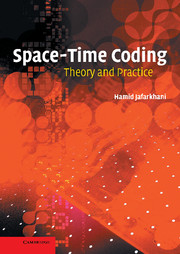Book contents
- Frontmatter
- Contents
- Preface
- Standard notation
- Space-time coding notation
- List of abbreviations
- 1 Introduction
- 2 Capacity of multiple-input multiple-output channels
- 3 Space-time code design criteria
- 4 Orthogonal space-time block codes
- 5 Quasi-orthogonal space-time block codes
- 6 Space-time trellis codes
- 7 Super-orthogonal space-time trellis codes
- 8 Differential space-time modulation
- 9 Spatial multiplexing and receiver design
- 10 Non-orthogonal space-time block codes
- 11 Additional topics in space-time coding
- References
- Index
3 - Space-time code design criteria
Published online by Cambridge University Press: 14 August 2009
- Frontmatter
- Contents
- Preface
- Standard notation
- Space-time coding notation
- List of abbreviations
- 1 Introduction
- 2 Capacity of multiple-input multiple-output channels
- 3 Space-time code design criteria
- 4 Orthogonal space-time block codes
- 5 Quasi-orthogonal space-time block codes
- 6 Space-time trellis codes
- 7 Super-orthogonal space-time trellis codes
- 8 Differential space-time modulation
- 9 Spatial multiplexing and receiver design
- 10 Non-orthogonal space-time block codes
- 11 Additional topics in space-time coding
- References
- Index
Summary
Background
A code is mapping from the input bits to the transmitted symbols. As discussed in Chapter 2, we assume that symbols are transmitted simultaneously from different antennas. In this chapter, we study the performance of different codes by deriving some bounds on them. Then, we use the bounds to provide some guidance to design codes with “good” performance. Such guidance is called the design criterion. Most of the analyses in this chapter are asymptotic analysis. Therefore, different asymptotic assumptions may result in different code criteria. We concentrate on a quasi-static Rayleigh fading wireless channel and some of the important design criteria that result in achieving maximum diversity and good performance at high SNRs.
A good code follows a design criterion that adds some notion of optimality to the code. In fact, the goal of defining a design criterion is to have a guideline for designing good codes. For example let us consider transmission over a binary symmetric channel using a linear binary block channel code. The bit error rate of the system depends on the Hamming distances of the codeword pairs. Defining the set of all possible codeword pairs and the corresponding set of Hamming distances, we denote the minimum Hamming distance by dmin. It can be shown that a code with minimum Hamming distance dmin can correct all error patterns of weight less than or equal to ⌊(dmin – 1)/2⌋, where ⌊x⌋ is the largest integer less than or equal to x.
- Type
- Chapter
- Information
- Space-Time CodingTheory and Practice, pp. 45 - 54Publisher: Cambridge University PressPrint publication year: 2005
- 1
- Cited by



